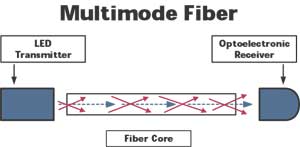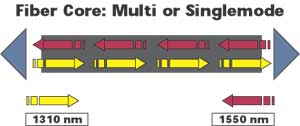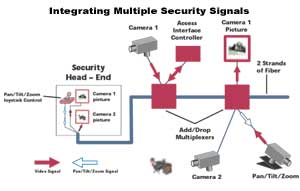
Fiber optics works by transmitting light rays in a glass strand. The physics of fiber optics are simple to explain and understand. Light signals can travel very long distances, and still be recognizable. When you look up at a starry night sky, you are seeing the lights generated from stars that are billions of miles from you. Yet your eyes, without aid of magnification or amplification, can see the individual stars in the sky. Even though the light rays may have been travelling for years before they reach you, they are still viewable. Because of resistance and interference, electrical signals can become indistinguishable in relatively short distances, where fiber can carry telephone signals from continent to continent, covering thousands of miles and retaining complete signal integrity.

In the 1960s it was found that silica glass, made from common sand, could be melted and formed into a solid thin strand or fiber that could be used to carry optical signals with an acceptable amount of loss over distance. After a lengthy developmental period, optical fiber systems were initially installed for testing by the telephone companies in the early 1980s, with the first commercial system linking New York City and Boston, carrying long-distance telephone calls.
Light rays can take multiple paths in a multimode fiber core.
The first type of fiber installed, and still in common use today, is called multimode.

A mode is a path for light rays, and multimode means multiple paths. An advantage of multimode fiber is that inexpensive LED light sources can be used in transmitters, with the multiple light rays entering the core simultaneously creating a cumulative amount of light power, allowing these signals to be usable to distances of four miles.
The standard size of multimode fiber is typically termed 62.5/125, with the first number indicating the diameter of the core, and the second the diameter of the cladding, with both measurements in microns, or millionths of a meter.
The cladding is also made of silica glass, specially manufactured so that the speed of light in the cladding is slower than the speed of light in the core glass. This difference in light-speed properties causes light rays traveling at severe angles to bend back into the core of the fiber when they meet the core/cladding boundary. This property results in total internal reflection, an important physical aspect of fiber optic transmission.
Millions of miles of multimode fiber strands are installed throughout the world, carrying LAN computer signaling, industrial control, and other applications. Multimode is limited to relatively short lengths, less than four miles, and is attractive for security applications because of its ease of termination, splicing, and testing.
SINGLEMODE IS DEVELOPED
The pulse spreading problem inherent in multimode fiber was a major impediment to the use of fiber by telecommunications companies, as they required signals to travel much further than four miles. Because of the development of laser light transmitters, a simple answer to pulse spreading was soon found. By building a fiber strand with a very small core, from 7 to 9 microns, and using focused laser light transmitters, entry of severe angled rays is eliminated, leaving only the centered light rays in the core. By eliminating the pulse spreading, the distance of transmission was greatly increased, and the age of long-distance fiber optic communications for telecommunications was born.
With the elimination of pulse spreading, optical signals can be transmitted up to 100 miles before amplification or regeneration is needed. And with the use of lasers, huge bandwidth can be sent on a single strand of singlemode fiber.
The technological development of fiber optics is truly astounding. By using tuned laser transmitters, up to 256 individual wavelengths can be transmitted on one strand of singlemode fiber, each carrying 40 Gigabits of data.
Stemming from its development by the telecommunications industry, fiber optics is a standardized technology. Fiber sizes and types are set, with 62.5/125 and 9/125 the industry standards for multimode and singlemode, respectively. The wavelengths used are 850 and 1300nm (nanometer = 1 billionth of a meter) for multimode, and 1310 and 1550nm in singlemode. This is an important advantage for those contractors new to the industry, as fiber optic testers use these same standard wavelengths to test fibers for quality. It is a simple process to use a fiber optic tester to ensure that a particular fiber will function properly with a certain transmitter/receiver set, by testing at the frequency used by the devices.

TRANSMISSION OPTIONS
Fiber offers exceptional flexibility in usage because of two properties – bi-directionality and multiple wavelengths. Bi-directionality allows two (or more) optical signals to be carried on a single strand of fiber.Just as your eyes can see multiple colors of light at the same instant, so can multiple wavelengths be transmitted and received in one fiber strand.
When these two physical properties are combined, many combinations of signals can be transmitted simultaneously on one or two strands of fiber.
Multiplexing of signals is common in fiber optic applications. In this scenario, multiple signals (for example, four video outputs from cameras) are connected to an electronic device that combines the four signals into one composite information stream. That is then transmitted on a single wavelength to the receiver, whose electronics will demux, or convert, the composite signal back into the four original signals. Such devices will use a multiplexing and compression method such as Time Division Multiple Access (TDMA), where each signal is assigned timed slots in the transmission stream to place their information.

Add/Drop multiplexing is another variant of fiber optic applications. Using a two-strand fiber bus, usually singlemode, electronic devices can be connected to the fibers that will both add addressed signals onto the fiber stream, and drop or pick off signals to be received at that point.
These systems are particularly well-suited for long-distance applications, where the monitoring of CCTV and access control needs to be performed at multiple locations, which are connected to one overall system.
Familiarity with these various methods of signal transmission can be exploited by the security integrator, particularly when previously installed (dark) fiber exists between two buildings or points needing security monitoring or control connections.
The basics of fiber optics are as simple as watching a blinking light in the distance, yet the technologies and applications available can be used to carry a multitude of different communication signals. By being aware of the possibilities, the security integrator can use fiber optics to their best advantage, providing their clients with flexible security systems that can use existing fiber strands to their fullest capability.
Sidebar: Key Reasons for Using Fiber Optics in CCTV and Access Control Applications
•Distance– Fiber versus Coax. In CCTV applications, copper coax can carry video signals less than 1,000 ft. without amplification, whereas the same signals can be transmitted tens of miles on a fiber optic strand.• Immunity to EMI and RFI. Because the signals in fiber optics are light waves, they are immune to interference that can distort electrical signals. As such, fiber optic systems can provide the highest picture quality over long distances, retaining quality images for DVR storage. This assumes, of course, that the picture quality was acceptable before it was transmitted on the fiber; optical transmitters will not improve a poor input signal.
• Security of Signal. Where it is fairly easy to tap or intercept electrical communications in copper cables, due to the magnetic field generated by electron movement, fiber optics is a much more secure communications link.
• Dark Fiber. There are literally millions of miles of unused fiber already installed in building campuses across the United States and the world. It is very common that a 12-strand fiber was installed between two buildings for computer network usage, with only two of the fibers being used. The remaining strands can be perfectly suited for security integration, after testing for functionality.
• Large Bandwidth. Transmission equipment is available from several manufacturers that can link a large number of electronic security devices, such as 128 video cameras onto a pair of singlemode fibers. These systems allow the security integration contractor to meet the requirements of the largest applications.
• Ethernet Security Devices. Electronic security manufacturers are embracing 10/100 Ethernet as a means of providing addressable devices with LAN access for authorized users. These cameras can be easily connected to low-cost media converters, which can pass these signals onto fibers for long-range communication. Such media converters are very commonly used for extending the distance of LAN communications. As product development matures, it may become less expensive to use Ethernet-enabled cameras with inexpensive media converters than to install analog cameras with purpose-built fiber optic security transmission equipment.
• Multiple Channel or Multiplexed Signals. Either technology can provide for multiple signals communicated bi-directionally in a single fiber strand. CCTV video, pan/tilt/zoom control, and access control signals all can be transmitted simultaneously. This provides the security integrator with a variety of system options that can be deployed onto a single pre-installed dark fiber that has been provided by the client.
